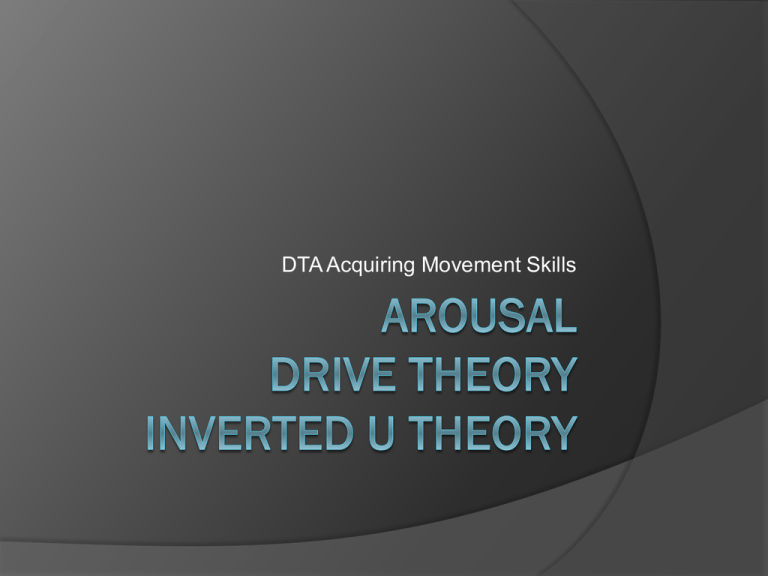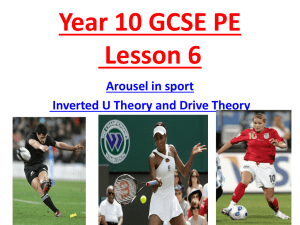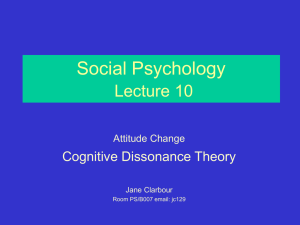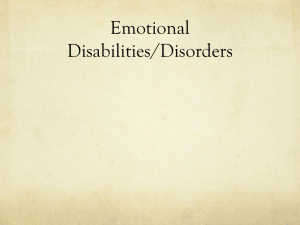Arousal Drive theory Inverted U theory
advertisement

DTA Acquiring Movement Skills How does arousal link to motivation? Intensity of behaviour is what is termed ‘arousal’. Intensity of behaviour refers to the degree of emotional energy that is felt in different situations. Like motivation it has two branches. Arousal Arousal is linked to the energised state that drives a person to learn or perform. Homeostasis If the body is deprived or affected (put under stress) then arousal levels in the body increase and we are motivated to behave in such a way as to reduce the levels to the optimum level of arousal. Somatic or physiological arousal Somatic relates to the changing state of the body. Changes to heart rate, blood pressure and respiration. Cognitive or psychological arousal relates to the mind e.g., moment to moment changes in worry or negative thought. Examples With your partner describe a sporting situation when you have felt or noticed physiological/ somatic changes. Do the same for cognitive/psychological arousal. If you have none then think of a sporting example you have seen. Drive Theory A relationship between arousal and performance. An increase in arousal is proportional to an increase in the quality of performance. The quality of performance depends on how well the skill has been learned. Juggle task. Have a novice and someone who is proficient. See how they fair when people are watching them. Does this support our theory? Drive Theory Explanation When arousal is evident the Dominant Response-behaviour is most likely to emerge. The dominant response is the motor programme that is already learned and will usually become evident when arousal is raised. Application of theory The novice performer, one at the cognitive or associative phase of learning should not be subjected to conditions that would evoke high arousal because at this level the dominant behaviour is likely to produce an ill timed and mistake-ridden performance. Application of theory Tennis player has learned correct technique. However, in a competitive game the first serve hits the net and because of the increased pressure/ arousal to get the second in They revert back to previously learned, error ridden serve. Application of theory High arousal would be beneficial to the expert performer. One at the autonomous stage of learning, because their dominant behaviour would tend to produce a response which is fluent and technically correct. Development Criticisms Together with an observation of real life situations and extensive research high class athletes have been seen to fail in high arousal situations. High class athletes are supposed to have grooved skills and therefore perform well in highly aroused states. Therefore, this approach has lost credibility. Summary and application High arousal is beneficial to expert performers/ their dominant response will produce more fluent responses. Novice learners (COG/ASS) dominant response will be less skilled and contain mistakes. A novice needs to learn in an environment of low arousal to concentrate on the skill being learned. Inverted U theory Indicates or predicts that as arousal increase so does the quality of performance. However, quality improves up to a point, midway on the axis. This is called the optimum point or the threshold of arousal. It predicts that the best performance occurs at moderate levels of arousal. If arousal occurs beyond the optimum point the performer becomes over-aroused and the capacity both to learn or perform a motor skill are deteriorated. Inverted U theory Point B Point A Point C state what you think will happen at point: A B C Explain reasons why this may happen and the impact on the performance. Point A Under arousal If concentration is limited the attention wanders to usually unwanted cues as the performer is under aroused. The player may appear to be daydreaming. In these circumstances the process of selective attention cannot operate. Information overload will then prevent accurate decision making. Playing at a lower level What would make you under aroused? Point B Optimum arousal This is considered the perfect state in which the potential performance is maximised. The attention field adjusts to the ideal width and as a result the learner or performer is able to concentrate. As concentration is high, means important information can be absorbed and accurate decision can be made. It is a product of selective attention and taking on board the most important information at the optimum point of arousal is called the Cue utilisation Hypothesis. Point C Over arousal causes What would make the youfield overof attention to narrow excessively. This may mean that aroused? the environmental cues may be missed. The performer is often in a state of near panic. This level of nervousness Anxiety, noise from the iscalled hyper vigilance. crowd, pressure of the The performer selective attention cannot event. Level of for operate and the capacity concentration is seriously impeded. experience Blind panic Diagram of different levels of arousal and phase of learning. 35 30 25 20 Elite Intermediate Novice 15 10 5 0 Category 1 Category 2 Category 3 Category 4 Read the passages on page 187 make notes in the booklet page 14-15 Complete the inverted work sheet. Variations in the optimum levels of arousal are caused by a combination of factors. Personality Which do you think perform better with a higher level of arousal: Introverts B / Extroverts. A Type of Task Which performs better with a high level of arousal: Gross and simple., rugby tackle A Fine and complex, putting in golf. B Development What can you suggest from your findings? motor skills that are mainly gross movement and relatively simple, using strength, endurance require little decision making are more effective with high levels or arousal. Note: within a sport there may be different arousal levels required at different times. Stage of learning Performance at cognitive level/ associative phase of learning. A Autonomous phase B Level of experience Low level of experience A More experienced performer B Application of knowledge 4 Q Using perceptual narrowing explain what different strategies a coach may use to develop a performers skills. 4 For the expert have some arousal but not too much as too much arousal can also hamper attention and in turn, create inaccurate decisions. Novice – level of arousal is initially low. Limiting the unwanted cues Increasing concentration and attention to accurate decision making. Catastrophe Theory Draw the diagram on your graphs and then explain it on the page using a sporting example. Start with the sentence, the catastrophe theory claims as somatic arousal increases so does quality of performance. Draw the points on the graph as you explain them. Use the terms cognitive and somatic arousal. These are the things that are raising and lowering. Point A This is the optimum point is the cognitive arousal can be maintained. If high cognitive arousal occurs with high somatic arousal you can tip over the edge. Point B Point B the performance drops dramatically ‘performer has a catastrophe’. Critical evaluation of inverted U theory and catastrophe theory. Very unlikely that we have a smooth decline in performance as increased arousal More likely that we will have, (if somatic and cognitive arousal are high) a sharp drop in performance. What will a somatic and cognitive heightened state of arousal look like? What would we expect to see? White boards. Somatic- Sweating, fast pulse, blood pressure raised. Cognitive- worry or negative thought. Exam Compare and contrast drive theory, inverted U theory and catastrophe theory as explanations for the relationship between arousal and performance of motor skills. [10] (Drive theory) • graph showing linear relationship between arousal and performance, with axes labelled; • performance increases as arousal increases; • dominant response is more likely to occur; • practical example; • explains performance of ballistic/dynamic gross/closed skills – opposed to other theories; • more likely with able performer opposed to other theories; • more motor programmes then more relevant; • theory does not explain how elite performers decline under pressure/high arousal opposed to other theories. (Inverted U theory) • graph (labelled) showing s-shaped curve with optimum point at moderate arousal and then a similar/steady decline in performance; • performance increases as arousal increases but only up to an optimum point/moderate arousal opposed to other theroies; • performance decreases as arousal gets higher than moderate; • practical example; • explains performance of games players/more complex/open skills opposed to other theories esp drive; • the more able will be able to cope with more arousal; • less able will need lower levels of arousal; • increase and decrease never as smooth/steady as graph indicates; • graph includes variables including task/ability/personality; • description of the Zone of optimal functioning (ZOF)/peak flow experience at optimum level of arousal. (Catastrophe theory) • graph (labelled) showing linear relationship between arousal and performance but a sudden decline in performance when arousal is high; • performance increases as arousal increases but suddenly/sharply decreases above moderate arousal opposed to other theories; • practical example; • theory is about effects of different types of anxiety – other theories do not; • interaction of two types of anxiety – somatic and cognitive; • performers reactions often dictated by cognitive anxiety; • if somatic anxiety low and cognitive high then improves performance; • if both high then can lead to a sudden/catastrophic effect opposed to other theories; • graph shows performance resuming at level below previous optimum as arousal lowers; • this is a multidimensional theory in contrast to the other two; • it is a more realistic theory than other two, because it explains sudden decreases in performances of elite performers.








